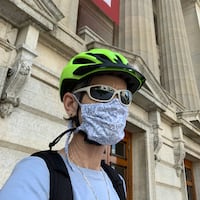The city of Dayton filed the legal challenge against the state of Ohio after legislators passed the law that curtails local authority to use traffic enforcement cameras.
Dayton challenged three elements of the law, which took effect in March 2015:
• that a full-time police officer be posted at each camera in operation;
• that cities conduct a three-year traffic study before deploying a camera;
• that speeders be given “leeway” — 6 miles per hour over in a school zone and 10 mph over elsewhere — before issuing tickets.
Related: Return of Dayton's red light cameras uncertain after Supreme Court arguments
Dayton Mayor Nan Whaley said residents want traffic cameras in their neighborhoods to make roadways less dangerous for motorists and pedestrians.
“We get asked regularly by neighborhoods to please put cameras in,” Whaley said.
Dayton still has fixed traffic cameras along various roadways and at intersections across the city, but the city no longer has a contract with the company that previously operated the devices.
Dayton officials said they will review the Supreme Court’s decision to decide how to proceed, and plans for traffic cameras are expected to change considerably.
The city wants to establish a thoughtful and effective camera program that improves community safety while not taxing law enforcement’s limited resources, Whaley said.
“We’ll go back and will be very forthright with the community about what we’re going to do, just like we’ve been the entire time,” Whaley said. “I’m very pro camera, but this ruling just came down.”
State may not be done targeting cameras
Even as city officials look at turning the cameras back on, state lawmakers are vowing to look for ways to shut them down again.
State Rep. Bill Seitz, R-Cincinnati, the architect of the law declared unconstitutional, said the ruling only applies to home-rule cities and the law is still in place for Ohio’s 1,300 townships and 88 counties as well as villages. When lawmakers return from summer recess in September, Seitz said they’ll consider requiring photo-enforcement tickets go through municipal courts instead of an administrative process.
Do you agree with today's ruling on red-light, traffic cameras in Ohio? https://t.co/O0ClODwppY
— Anthony Shoemaker (@DaytonPolitics) July 26, 2017
The state may withhold local government fund money from cities that receive money from traffic cameras, he said. “Since they’re getting money that way, they obviously don’t need our money. I think those two things would have a very salutary effect in taking the profit out of the policing for profit equation and render the decision today a pyrrhic victory for those folks like Dayton and Toledo that think they are above the law.”
Seitz said an outright ban could be put in place through a constitutional amendment — something he said is not being considered at this time.
Senate President Larry Obhof, R-Medina, said “I think the people of Ohio overwhelmingly oppose red light cameras. The Legislature tends to feel the same way.”
Obhof said he has yet to review the ruling in the Dayton case. He noted that he would consider a ban bill if he believes it has a chance of withstanding a constitutional challenge. “It doesn’t do us any good for us to pass another law that we expect to be struck down. So anything that we would do from here out, as when we worked on it the first time, we’ll take our time, try to be thoughtful about it and come up with a result that maybe the courts will agree with, maybe they won’t, but one that we think going in will withstand scrutiny.”
Before the law took effect, Dayton asked the common pleas court to declare elements of the law unconstitutional. The trial court agreed with the city but the Second District Court of Appeals overturned that decision. The city then took it to the supreme court.
The ruling
The Ohio Constitution, adopted in 1912, gives municipalities “home-rule” powers of self-governance as long as local ordinances don’t conflict with the state’s general laws.
Justice Patrick Fischer, writing the majority opinion, said that the law “infringes on the municipality’s’s legislative authority without serving an overriding state interest and is therefore unconstitutional.”
The supreme court ruled that the requirement that an officer be present while cameras are operating contradicts the purpose of deploying cameras to conserve police resources. It also said prescribing a “leeway” improperly dictates to cities how they must enforce speed limits within the city limits and it operates “as a de facto increase in speed limits in the limited areas covered by a traffic camera.”
Justices William O’Neill and Patrick DeWine dissented on the ruling, saying that the law promotes the uniform application of traffic regulations across the state.
In his dissent, DeWine said justices in the majority were over-stepping into legislators’ roles.
Credit: DaytonDailyNews
Related: Dayton to reboot its traffic camera program
“But today, the plurality in essence says we know what is in the sate’s interest better than those 132 representatives of the people do. And if we don’t think a law is a good idea, then it must not be a general law, and we can strike it down,” DeWine wrote.
The decision only strikes down the three elements of the law that Dayton challenged. Other provisions remain in effect, including a requirement that camera manufacturers provide maintenance records to local authorities and a prohibition on insurance companies using camera-caught violations to set motorists’ policies and rates.
Dayton began using traffic cameras in 2002, first to enforce red-light traffic violations and later to catch speeders. Accidents decreased where cameras operated. Other cities and villages across the state also used traffic cameras to catch violators.
While Dayton was the lead on the case decided Wednesday, Springfield, Akron, East Cleveland, Toledo and the Ohio Municipal League weighed in with briefs supporting Dayton’s argument. The Municipal League represents 700 cities and villages.
In oral arguments held in January before the high court, Dayton said that the General Assembly specifically wrote the law to block local jurisdictions from using the cameras. Dayton had more than 36 cameras operating when the law took effect.
The state argued that municipalities could still use cameras to issue citations as long as they followed the law and local ordinances didn’t conflict with the state statute. The state said the law provides a statewide framework on the use of traffic cameras.
Meanwhile, Dayton city officials approved a plan to bring back cameras to catch speeding and red light violations. The city plans to use 10 fixed camera systems, six hand-held devices and two portable trailer units. Officers will be present when any of these devices are in operation and documenting traffic violations.
Related: Traffic cameras coming back to Dayton at these locations
--
TIMELINE OF THE CASE



